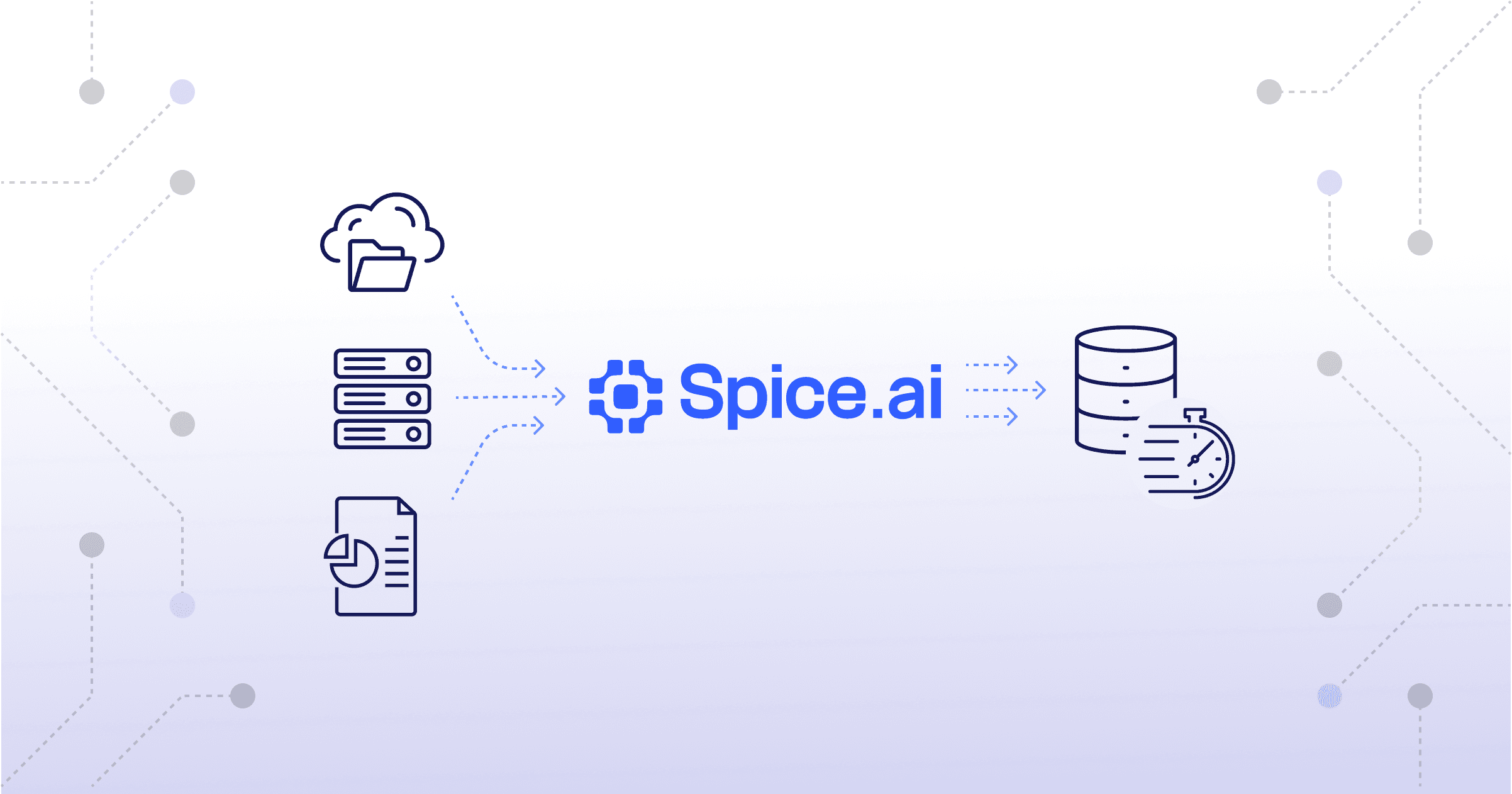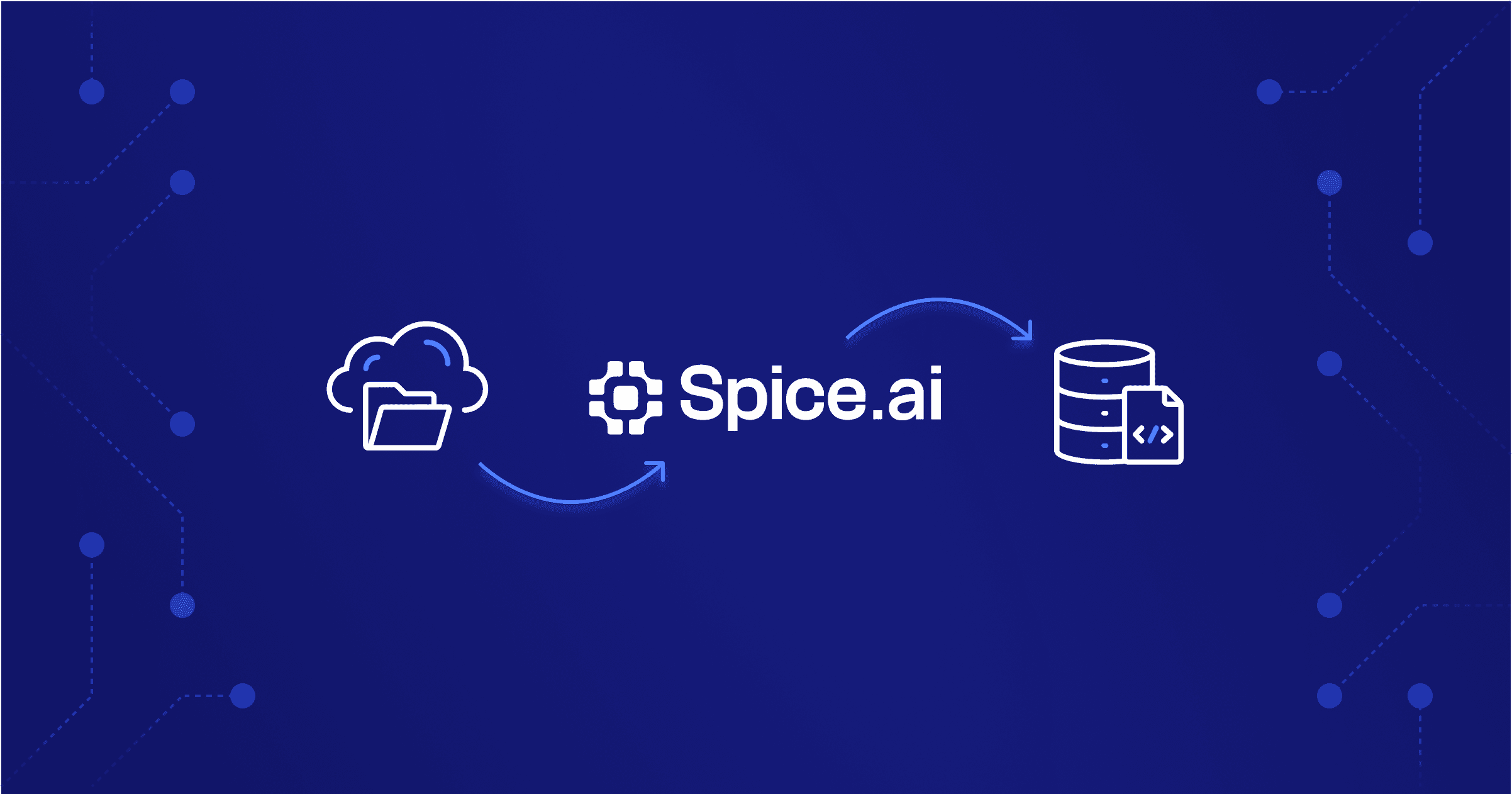Write to Apache Iceberg Tables with SQL in Spice
With the release of Spice v1.8, developers can now write directly to Apache Iceberg tables and catalogs using standard SQL INSERT_INTO statements.
This feature extends Spice’s SQL federation capabilities beyond reads, enabling data ingestion, transformation, and pipeline workloads to write results back into Iceberg directly from the same runtime used for queries and acceleration.
What sets Spice apart from other query engines is its broader, application-focused feature set designed for modern data and AI workloads. Spice brings together federation, hybrid search, embedded LLM inference, and now native writes in one unified runtime - enabling teams to build complete, end-to-end workflows without the management overhead and performance concessions of using multiple systems.
Iceberg write support is available in preview, with append-only operations and schema validation for secure and predictable data management.
From Read-Only Federation to Full Data Workflows
Data teams are standardizing on open table formats like Apache Iceberg to unify analytical and operational data across systems; Iceberg offers a consistent way to store, version, and manage data across different engines and clouds, helping teams avoid vendor lock-in while maintaining strong governance and interoperability.
Supporting Iceberg writes natively inside Spice means development teams can:
- Direct Writes to Iceberg without ETL: Insert data directly into Iceberg from SQL queries.
- Simplify ingestion paths: Load transformed or federated data into Iceberg without separate tools.
- Enforce governance: Maintain schema validation and secure access through read_write permissions.
Paired with Spice’s built-in performance acceleration and federation, these write capabilities make it easier to use Iceberg not just as a storage solution, but as a queryable data layer for both operational and AI workloads
How It Works
Spice supports INSERT_INTO statements on Iceberg tables and catalogs explicitly marked as read_write.
Example Spicepod configuration:
catalogs:
- from: iceberg:http://localhost:8181/v1/namespaces
access: read_write # Uncomment this line
name: ice
params:
iceberg_s3_endpoint: http://localhost:9000
iceberg_s3_access_key_id: admin
iceberg_s3_secret_access_key: password
iceberg_s3_region: us-east-1And, here's an example SQL query:
-- Insert from another table
INSERT INTO iceberg_table
SELECT * FROM existing_table;
-- Insert with values
INSERT INTO iceberg_table (id, name, amount)
VALUES (1, 'John', 100.0), (2, 'Jane', 200.0);
-- Insert into catalog table
INSERT INTO ice.sales.transactions
VALUES (1001, '2025-01-15', 299.99, 'completed');Support for updates, deletes, and merges will be added in future releases.
Now, let’s walk through an end-to-end workflow demonstrating how to execute Iceberg writes in Spice.
Write to Iceberg Tables with Spice Cookbook
Prerequisites:
- Access to an Iceberg catalog, or Docker to run an Iceberg catalog locally.
- Spice is installed (see the Getting Started documentation).
Step 1: Create a new directory and initialize a Spicepod
mkdir iceberg-catalog-recipe
cd iceberg-catalog-recipe
spice initStep 2. Run the Docker container for the Iceberg catalog
In a separate terminal, clone the cookbook repository and run the Docker container for the Iceberg catalog.
git clone https://github.com/spiceai/cookbook.git
cd cookbook/catalogs/iceberg
docker compose up -dStep 3. Add the Iceberg Catalog Connector to your Spicepod
catalogs:
- from: iceberg:http://localhost:8181/v1/namespaces
# access: read_write
name: ice
params:
iceberg_s3_endpoint: http://localhost:9000
iceberg_s3_access_key_id: admin
iceberg_s3_secret_access_key: password
iceberg_s3_region: us-east-1Step 4. Run Spice
spice run
2025/01/27 11:08:36 INFO Checking for latest Spice runtime release...
2025/01/27 11:08:37 INFO Spice.ai runtime starting...
2025-01-27T19:08:37.494155Z INFO runtime::init::dataset: No datasets were configured. If this is unexpected, check the Spicepod configuration.
2025-01-27T19:08:37.494905Z INFO runtime::init::catalog: Registering catalog 'ice' for iceberg
2025-01-27T19:08:37.499162Z INFO runtime::metrics_server: Spice Runtime Metrics listening on 127.0.0.1:9090
2025-01-27T19:08:37.499174Z INFO runtime::flight: Spice Runtime Flight listening on 127.0.0.1:50051
2025-01-27T19:08:37.500689Z INFO runtime::http: Spice Runtime HTTP listening on 127.0.0.1:8090
2025-01-27T19:08:37.503376Z INFO runtime::opentelemetry: Spice Runtime OpenTelemetry listening on 127.0.0.1:50052
2025-01-27T19:08:37.696469Z INFO runtime::init::results_cache: Initialized results cache; max size: 128.00 MiB, item ttl: 1s
2025-01-27T19:08:37.697178Z INFO runtime::init::catalog: Registered catalog 'ice' with 1 schema and 8 tablesStep 5. Query the Iceberg catalog
spice sql
sql> show tables;
+---------------+--------------+--------------+------------+
| table_catalog | table_schema | table_name | table_type |
+---------------+--------------+--------------+------------+
| ice | tpch_sf1 | lineitem | BASE TABLE |
| ice | tpch_sf1 | nation | BASE TABLE |
| ice | tpch_sf1 | orders | BASE TABLE |
| ice | tpch_sf1 | supplier | BASE TABLE |
| ice | tpch_sf1 | customer | BASE TABLE |
| ice | tpch_sf1 | partsupp | BASE TABLE |
| ice | tpch_sf1 | region | BASE TABLE |
| ice | tpch_sf1 | part | BASE TABLE |
| spice | runtime | task_history | BASE TABLE |
| spice | runtime | metrics | BASE TABLE |
+---------------+--------------+--------------+------------+Run Pricing Summary Report Query (Q1). More information about TPC-H and all the queries involved can be found in the official TPC Benchmark H Standard Specification.
select
l_returnflag,
l_linestatus,
sum(l_quantity) as sum_qty,
sum(l_extendedprice) as sum_base_price,
sum(l_extendedprice * (1 - l_discount)) as sum_disc_price,
sum(l_extendedprice * (1 - l_discount) * (1 + l_tax)) as sum_charge,
avg(l_quantity) as avg_qty,
avg(l_extendedprice) as avg_price,
avg(l_discount) as avg_disc,
count(*) as count_order
from
ice.tpch_sf1.lineitem
where
l_shipdate <= date '1998-12-01' - interval '110' day
group by
l_returnflag,
l_linestatus
order by
l_returnflag,
l_linestatus
;Output:
+--------------+--------------+-------------+-----------------+-------------------+---------------------+-----------+--------------+----------+-------------+
| l_returnflag | l_linestatus | sum_qty | sum_base_price | sum_disc_price | sum_charge | avg_qty | avg_price | avg_disc | count_order |
+--------------+--------------+-------------+-----------------+-------------------+---------------------+-----------+--------------+----------+-------------+
| A | F | 37734107.00 | 56586554400.73 | 53758257134.8700 | 55909065222.827692 | 25.522005 | 38273.129734 | 0.049985 | 1478493 |
| N | F | 991417.00 | 1487504710.38 | 1413082168.0541 | 1469649223.194375 | 25.516471 | 38284.467760 | 0.050093 | 38854 |
| N | O | 73416597.00 | 110112303006.41 | 104608220776.3836 | 108796375788.183317 | 25.502437 | 38249.282778 | 0.049996 | 2878807 |
| R | F | 37719753.00 | 56568041380.90 | 53741292684.6040 | 55889619119.831932 | 25.505793 | 38250.854626 | 0.050009 | 1478870 |
+--------------+--------------+-------------+-----------------+-------------------+---------------------+-----------+--------------+----------+-------------+
Time: 0.186233833 seconds. 10 rows.Step 6. Write to Iceberg tables
To enable write operations to Iceberg tables, uncomment the access: read_write configuration and restart Spice.
6.1. Update the Spicepod configuration
Edit the spicepod.yaml file to uncomment the access line:
catalogs:
- from: iceberg:http://localhost:8181/v1/namespaces
access: read_write # Uncomment this line
name: ice
params:
iceberg_s3_endpoint: http://localhost:9000
iceberg_s3_access_key_id: admin
iceberg_s3_secret_access_key: password
iceberg_s3_region: us-east-16.2. Restart Spice
Stop the current Spice instance (Ctrl+C) and restart it:
spice run6.3. Insert data into Iceberg tables
Now you can write data to the Iceberg tables using SQL INSERT statements:
spice sqlExample: Insert a new region into the region table:
INSERT INTO ice.tpch_sf1.region (r_regionkey, r_name, r_comment)
VALUES (5, 'ANTARCTICA', 'A cold and remote region');
+-------+
| count |
+-------+
| 1 |
+-------+Example: Insert a new nation into the nation table:
INSERT INTO ice.tpch_sf1.nation (n_nationkey, n_name, n_regionkey, n_comment)
VALUES (25, 'PENGUINIA', 5, 'A vibrant home for brave penguins in Antarctica');
+-------+
| count |
+-------+
| 1 |
+-------+Verify the inserts by querying the tables:
SELECT * FROM ice.tpch_sf1.region WHERE r_regionkey = 5;
SELECT * FROM ice.tpch_sf1.nation WHERE n_nationkey = 25;Step 7. View the Iceberg tables in MinIO
Navigate to http://localhost:9001 and login with admin and password. View the iceberg bucket to see the created Iceberg tables.
Step 8. Clean up
docker compose down --volumes --rmi localNext steps with Iceberg writes in Spice
Iceberg write support is available in preview. See the Iceberg connector docs for configuration details and try the Iceberg Catalog Connector recipe to get started.
Feedback is welcome as we round out support for Iceberg writes in upcoming releases!
Explore more Spice resources
Tutorials, docs, and blog posts to help you go deeper with Spice.
Build Better Apps with Spice.ai SQL Query Federation & Acceleration
Modern applications succeed when they can deliver speed, intelligence, and reliability at scale. Achieving that depends increasingly on how quickly and efficiently they can access the relevant underlying data sources. Most enterprises, however, rely on pipelines, warehouses, and APIs that make real-time or intelligent apps prohibitively expensive or slow. Engineering teams are faced with how […]

Making Object Storage Operational for Real-Time and AI Workloads
TLDR Introduction Although legacy systems and workflows remain common, many enterprises are re-evaluating their architectures to meet new demands – driven in part, but not exclusively, by AI – that require support for more data-intensive and real-time applications. The underlying storage needs for these novel workloads are generally outside the bounds of a traditional operational […]

See Spice in action
Get a guided walkthrough of how development teams use Spice to query, accelerate, and integrate AI for mission-critical workloads.
Get a demo



